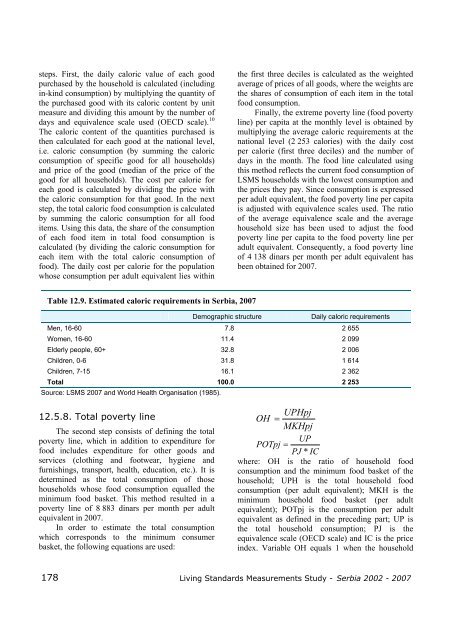Living Standards Measurements Study - Serbia 2002 - 2007
Living Standards Measurements Study - Serbia 2002 - 2007
Living Standards Measurements Study - Serbia 2002 - 2007
You also want an ePaper? Increase the reach of your titles
YUMPU automatically turns print PDFs into web optimized ePapers that Google loves.
steps. First, the daily caloric value of each good<br />
purchased by the household is calculated (including<br />
in-kind consumption) by multiplying the quantity of<br />
the purchased good with its caloric content by unit<br />
measure and dividing this amount by the number of<br />
10<br />
days and equivalence scale used (OECD scale).9F<br />
The caloric content of the quantities purchased is<br />
then calculated for each good at the national level,<br />
i.e. caloric consumption (by summing the caloric<br />
consumption of specific good for all households)<br />
and price of the good (median of the price of the<br />
good for all households). The cost per calorie for<br />
each good is calculated by dividing the price with<br />
the caloric consumption for that good. In the next<br />
step, the total caloric food consumption is calculated<br />
by summing the caloric consumption for all food<br />
items. Using this data, the share of the consumption<br />
of each food item in total food consumption is<br />
calculated (by dividing the caloric consumption for<br />
each item with the total caloric consumption of<br />
food). The daily cost per calorie for the population<br />
whose consumption per adult equivalent lies within<br />
the first three deciles is calculated as the weighted<br />
average of prices of all goods, where the weights are<br />
the shares of consumption of each item in the total<br />
food consumption.<br />
Finally, the extreme poverty line (food poverty<br />
line) per capita at the monthly level is obtained by<br />
multiplying the average caloric requirements at the<br />
national level (2 253 calories) with the daily cost<br />
per calorie (first three deciles) and the number of<br />
days in the month. The food line calculated using<br />
this method reflects the current food consumption of<br />
LSMS households with the lowest consumption and<br />
the prices they pay. Since consumption is expressed<br />
per adult equivalent, the food poverty line per capita<br />
is adjusted with equivalence scales used. The ratio<br />
of the average equivalence scale and the average<br />
household size has been used to adjust the food<br />
poverty line per capita to the food poverty line per<br />
adult equivalent. Consequently, a food poverty line<br />
of 4 138 dinars per month per adult equivalent has<br />
been obtained for <strong>2007</strong>.<br />
Table 12.9. Estimated caloric requirements in <strong>Serbia</strong>, <strong>2007</strong><br />
Demographic structure<br />
Daily caloric requirements<br />
Men, 16-60 7.8 2 655<br />
Women, 16-60 11.4 2 099<br />
Elderly people, 60+ 32.8 2 006<br />
Children, 0-6 31.8 1 614<br />
Children, 7-15 16.1 2 362<br />
Total 100.0 2 253<br />
Source: LSMS <strong>2007</strong> and World Health Organisation (1985).<br />
12.5.8. Total poverty line<br />
The second step consists of defining the total<br />
poverty line, which in addition to expenditure for<br />
food includes expenditure for other goods and<br />
services (clothing and footwear, hygiene and<br />
furnishings, transport, health, education, etc.). It is<br />
determined as the total consumption of those<br />
households whose food consumption equalled the<br />
minimum food basket. This method resulted in a<br />
poverty line of 8 883 dinars per month per adult<br />
equivalent in <strong>2007</strong>.<br />
In order to estimate the total consumption<br />
which corresponds to the minimum consumer<br />
basket, the following equations are used:<br />
UPHpj<br />
OH =<br />
MKHpj<br />
UP<br />
POTpj =<br />
PJ * IC<br />
where: OH is the ratio of household food<br />
consumption and the minimum food basket of the<br />
household; UPH is the total household food<br />
consumption (per adult equivalent); MKH is the<br />
minimum household food basket (per adult<br />
equivalent); POTpj is the consumption per adult<br />
equivalent as defined in the preceding part; UP is<br />
the total household consumption; PJ is the<br />
equivalence scale (OECD scale) and IC is the price<br />
index. Variable OH equals 1 when the household<br />
178 <strong>Living</strong> <strong>Standards</strong> <strong>Measurements</strong> <strong>Study</strong> - <strong>Serbia</strong> <strong>2002</strong> - <strong>2007</strong>















